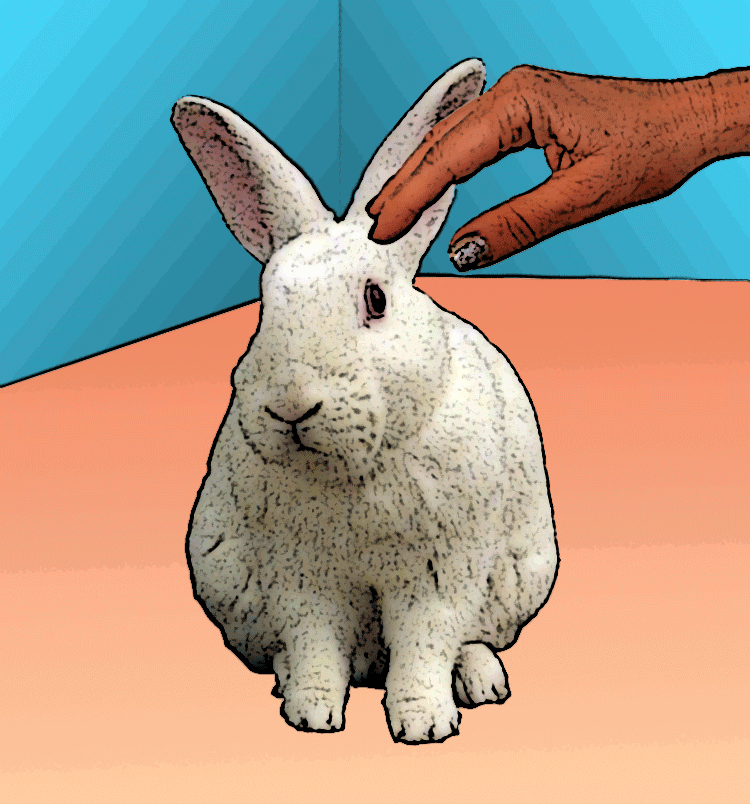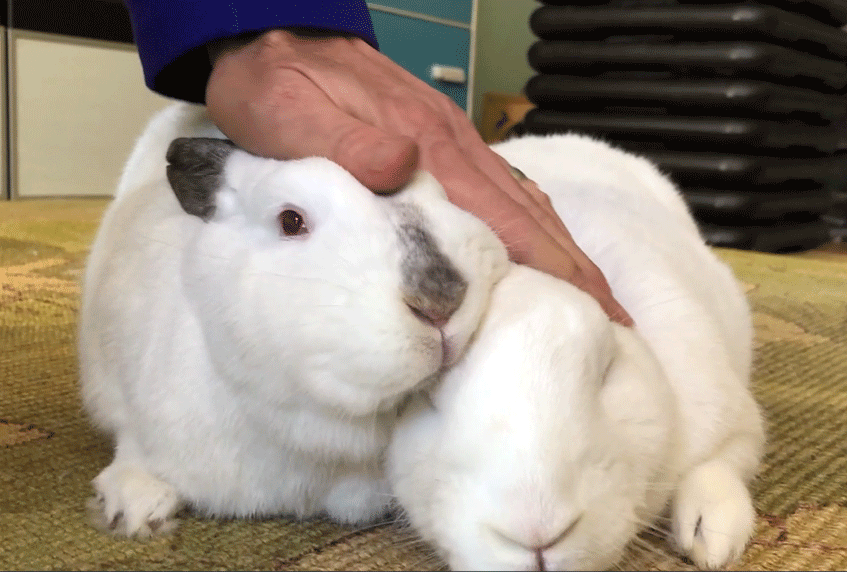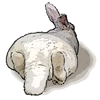
When you see furballs as cute as rabbits, you immediately want to pet them. But do the objects of your adoration welcome your enthusiastic touch?
Consider my experience — not as a bunny, but as a kid. I used to dread greeting family friend “Uncle Jack” because he’d plant these incredibly sloppy kisses on our cheeks. Knowing it would be rude to rebuff his frothy howdys, I’d smile weakly until he turned away, then quickly wipe my face.
So, how can you avoid being the equivalent of “Uncle Jack” to the rabbits in your life?
The Challenge of Getting Consent

For bunnies you know well, you probably have a general idea of their attitude towards being petted. Some, like our smudge-nosed Moraea, are usually happy with human massages, provided you follow basic rabbit-petting etiquette . Some find it scary most of the time, and still others, like big, frosty-furred Finnegan, are more variable — sometimes in the mood, and sometimes not.
But all animals, even those like Moraea, should be given a choice about participating. Even dogs — although we commonly think of them as very human-centric — don’t always want our touch. Without a shared language, most people don’t know how to ask an animal what they want.
The Solution: Permission to Pet
Animal behaviorist Eileen Anderson has an answer— at least for dogs. She tries a “Consent Test” to ask the dog if he wants pets, as shown in a video on her blog . I thought this was genius, and at the same time, like she says, it seems obvious once you know about it.
The power of this approach is in establishing trust. Consider what happens if your bun wants you to stop petting but you persist: you’re teaching him to stay away from you if he doesn’t want your touch. By contrast, if you show him that you’ll stop or refrain when he’s not in the mood, he’ll be more likely to spend time near you.
Rabbit body language is a bit different from dogs, but a similar approach can be used. A good way to start is to move your hand towards the top of the rabbit’s head. If he moves his head away, that’s a “No.” If he keeps it still, or extends it towards you, that’s a “Yes.”
You can also try taking your hand away when petting a rabbit, as Anderson does with the dogs. If the rabbit wants more, it’s possible they’ll move towards your hand, but if they’re relaxed, they typically stay still. I think either of these constitutes a “Yes.”
If at any time during a petting session the bun turns away or moves away, that’s “I’ve had enough for now, you’re excused.”
See It In Action
To demonstrate, I took video of a few snuggle sessions with our guys. In this first one, Moraea’s enjoying a nice massage and Finnegan has come over to see what we’re up to. He appears to think about it for a while. He starts signaling some interest by sniffing around, so I invite him to join, then back off to see how he reacts. His answer: “Yep, I’ll take some of that, too.”
In the example below, Moraea wants to interact with my hand, but she’s just hoping it will give her some treats. She says “No” repeatedly to my offers of pets. Finnegan, on the other hand, responds with an enthusiastic “You betcha!”
In this final example, Moraea and Finnegan are both enjoying a snuggle session, but after a while Finnegan decides he’s done and would rather have a bath. When I offer to continue petting, he “tells” me to stop.
A More Complex Conversation
Recently I had an inter-species dialogue about petting that got even more sophisticated.
Finnegan and Moraea know that when I am stretching on my yoga mat they can join me and I’ll pet them. Yesterday, as I settled in, Finnegan approached and began licking the mat. I stroked his head a few times, and he flattened out and relaxed for a moment as I continued. But then, suddenly, he jerked his nose up and back forcefully, “throwing” my hand rearward.
I pulled back, thinking he must have decided he didn’t want pets. Typically when that’s the case he moves away. But he remained where he was, head extended, and began licking the mat again. Now I felt confused. This didn’t look like a “No.” Then what was it? Might he be saying “Further back”?
I reached over to pet him again, but this time, I started at the shoulders and ran my fingers down his back. He sank down and relaxed fully, letting me ruffle and smooth the thick coat on his back up and down for as long as I would stay.
It’s impossible to know for sure what an animal is thinking. I certainly could be reading too much into this event. But the head jerk was so forceful and deliberate that it seemed to me it must be communicating something. If the message was “Buzz off, sister,” surely he would have forcefully rebuffed my second attempt to pet, but he didn’t. I noticed he was shedding quite a bit, and as I stroked his back I was lifting off a good deal of loose fur. It’s possible that’s what he was after — a little help with grooming in that area.
It was memorable and meaningful to me to sense that, not only did Finnegan want my touch, he was telling me exactly how he wanted it. I was only too happy to oblige once I figured out what he was saying.
 The Fluffy Tail of This Blog Post
The Fluffy Tail of This Blog Post
Using his/her body language to determine when and how your bunny wants to be touched is a powerful means of interspecies communication. Learning to do this has helped me to grant my cute companions the autonomy they deserve and also strengthened the bond of trust we share. I hope you’ll try it and teach it to others, too.
Syl says:
I’ll have to reread this before I come to visit!